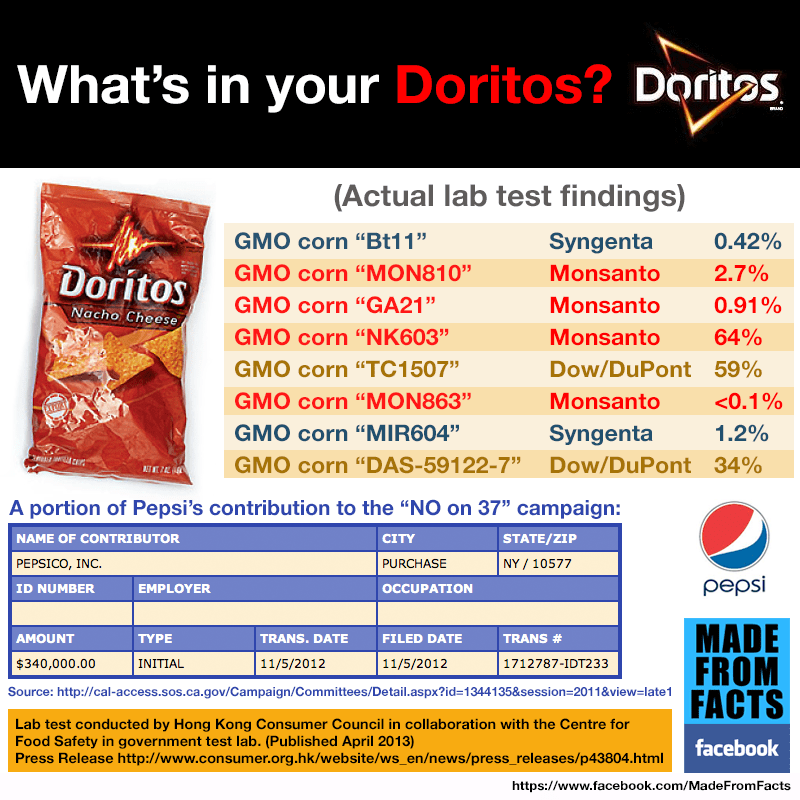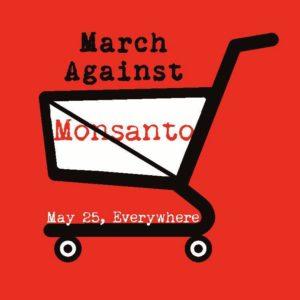If you’re an American who eats conventionally grown and processed foods – even if rarely – chances are good you’ve ingested some GMO corn.
Not only is 88% of domestic corn genetically modified, but derived products such as high fructose corn syrup and corn starch ensure that the stuff shows up even where you wouldn’t expect it. More than 25% of all supermarket products – edible and non-edible alike – contain corn, wrote Michael Pollan in The Omnivore’s Dilemma. Tissue analysis has shown that, as the Berkeley biologist he spoke with put it, “we North Americans look like corn chips with legs.”
And those corn chips contain plenty of GMOs. Consider what you might find in a bag of Doritos (a brand owned by anti-labeling PepsiCo):

Recently, a consumer group called Moms Across America called attention to a new report on the health risks of GMO corn. The study, provided by an individual from the De Dell Seed Company (“Canada’s only NON GMO corn seed company”), found GMO corn to be not only substantially less nutritious but highly toxic, containing 200 times the amount of formaldehyde considered toxic and “130,000 times higher than what is toxic in water!”
If this research holds up, it gives us one of the sharpest pictures yet of how it’s not just what’s in GMO corn that’s a problem (toxins) but what’s not in it (nutritional value) that contributes to the sub-optimal health and increased health problems documented by an ever growing body of research on GMOs.
The paper also lends weight to other important GMO corn studies from recent years, such as the 2009 International Journal of Biological Sciences paper which linked liver and kidney damage to three different strains of GMO corn. Their data, they wrote,
strongly suggests that these GM maize varieties induce a state of hepatorenal toxicity….These substances have never before been an integral part of the human or animal diet and therefore their health consequences for those who consume them, especially over long time periods are currently unknown.
A Food and Chemical Toxicology study published the following year also found evidence of organ damage in rats, as well as increased tumor risk. While some loudly criticized the methodology of this research, its author – Gilles-Eric Séralini of the University of Caen (France) – stood by them.
Interestingly, one common complaint was that Séralini followed his lab rats for nearly their entire lifespan, not the 90 day period favored by regulators. While this makes the results quite different from those of short-term studies, it also may make them more relevant. After all, the effects of GMOs will be with us human lab rats for a lifetime, too. And we’ve seen some terrible consequences of relying on short-term studies to approve pharmaceutical drugs a person may take for the rest of their life.
Fortunately, more physicians and health organizations are speaking out against the consumption of GMO foods – foods which, Michael Pollan has said, offer “nothing” to consumers.
That’s why [Monsanto] has to be so quiet about it. They love to talk to farmers and they love to talk to Wall Street but they don’t like to talk to consumers because they don’t have a story tell – yet. When they come up with products that are nutritionally enhanced, or save on calories, it’s another conversation.
We’re sure it’ll be a doozy.
 Meantime, there’s more you can do beyond simply avoiding GMOs in stores and eateries. On May 25, there will be gatherings around the world for the March Against Monsanto – including one right here in Houston.
Meantime, there’s more you can do beyond simply avoiding GMOs in stores and eateries. On May 25, there will be gatherings around the world for the March Against Monsanto – including one right here in Houston.
Monsanto is a bio-technology corporation, known for their biological weapons, highly controversial patents on seeds and the creation of the genetically modified organisms (GMO’s) in the world’s food supply. Currently, marches are being planned on six continents, in 36 countries, totaling events in over 250 cities, and in the US, events are slated to occur simultaneously at 1 PM Central Time in 47 states. The activists organizing the Houston event invite everyone who support this cause in Houston and surrounding areas to participate.
Full details are available on the event’s Facebook page.
Outside of Houston? You can find out about local actions here.